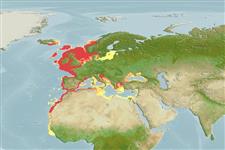Common names from other countries
Environment: milieu / climate zone / depth range / distribution range
Ecologia
marino demersale; distribuzione batimetrica 20 - 318 m (Ref. 56504). Subtropical; 8°C - 24°C (Ref. 4944); 66°N - 9°N, 18°W - 42°E
Eastern Atlantic: Norway to Cape Blanc (along the African coast); not recorded at Madeira and the Azores. Also in the Mediterranean and Black seas.
Length at first maturity / Size / Peso / Age
Maturity: Lm 24.7 range ? - ? cm
Max length : 82.8 cm TL maschio/sesso non determinato; (Ref. 113018); common length : 30.0 cm TL maschio/sesso non determinato; (Ref. 3397); peso massimo pubblicato: 6.6 kg (Ref. 113018); Età massima riportata: 15 anni (Ref. 26811)
Longest ray in the pectoral fin reaching the front part of the anal fin. Lateral line scales smooth. Reddish color (Ref. 35388).
Occurs at temperatures ranging from 8.0-24.0 °C (Ref. 4944). Inhabits sand, muddy sand or gravel bottoms. Up to depth of 318 m in the eastern Ionian Sea (Ref. 56504). Feeds on fish, crustaceans and mollusks. Has three isolated rays on the pectoral fin which function as legs on which the fish rests and also help in locating food on the soft bottom (Ref. 9988). Marketed fresh or frozen; eaten pan-fried, broiled, microwaved or baked (Ref. 9988).
Distinct pairing during breeding (Ref. 205).
Richards, W.J. and V.P. Saksena, 1990. Triglidae. p. 680-684. In J.C. Quero, J.C. Hureau, C. Karrer, A. Post and L. Saldanha (eds.) Check-list of the fishes of the eastern tropical Atlantic (CLOFETA). JNICT, Lisbon; SEI, Paris; and UNESCO, Paris. Vol. 2. (Ref. 3687)
IUCN Red List Status (Ref. 130435)
CITES (Ref. 128078)
Not Evaluated
Threat to humans
Harmless
Human uses
Pesca: commerciale; Pesce da pesca sportiva: si; Acquario: Acquari pubblici
Strumenti
Special reports
Download XML
Fonti Internet
Estimates based on models
Preferred temperature (Ref.
115969): 7 - 16, mean 9.8 (based on 453 cells).
Phylogenetic diversity index (Ref.
82804): PD
50 = 0.5010 [Uniqueness, from 0.5 = low to 2.0 = high].
Bayesian length-weight: a=0.00776 (0.00657 - 0.00916), b=3.03 (2.98 - 3.08), in cm Total Length, based on LWR estimates for this species (Ref.
93245).
Trophic level (Ref.
69278): 4.0 ±0.0 se; based on diet studies.
Resilienza (Ref.
120179): Basso, tempo minimo di raddoppiamento della popolazione 4.5 - 14 anni (K=0.15-1.6(?); tmax=14; tm=3).
Fishing Vulnerability (Ref.
59153): Moderate to high vulnerability (55 of 100).
Climate Vulnerability (Ref.
125649): Moderate vulnerability (38 of 100).
